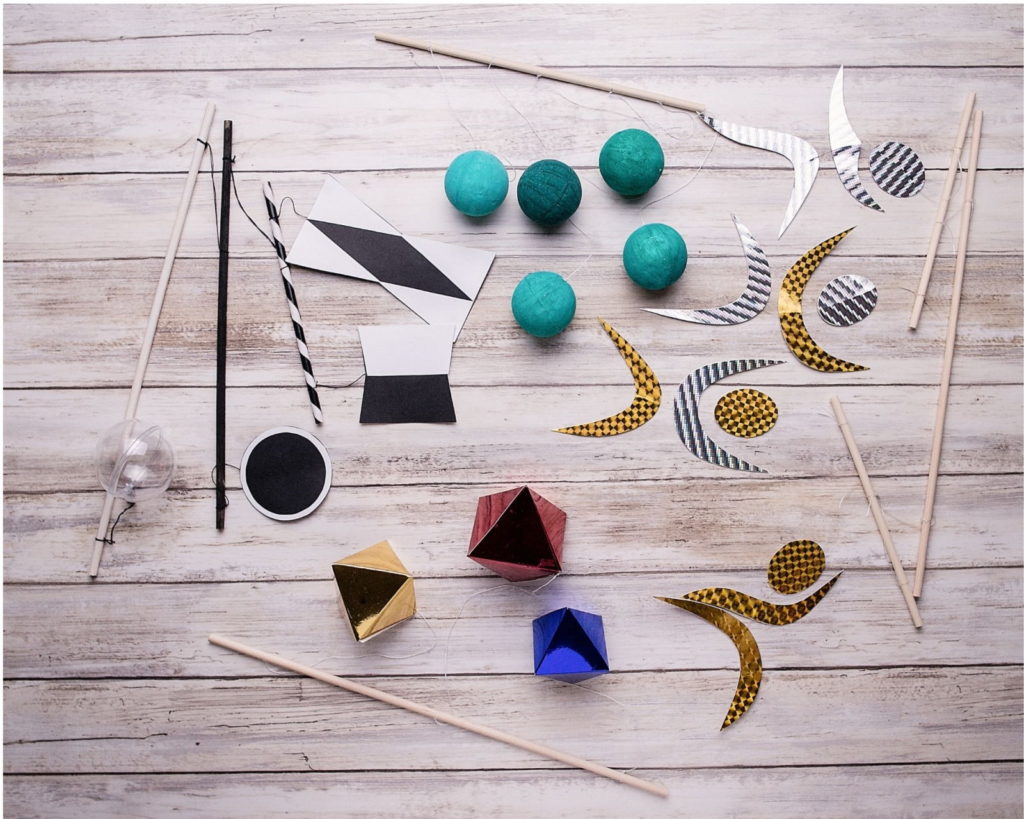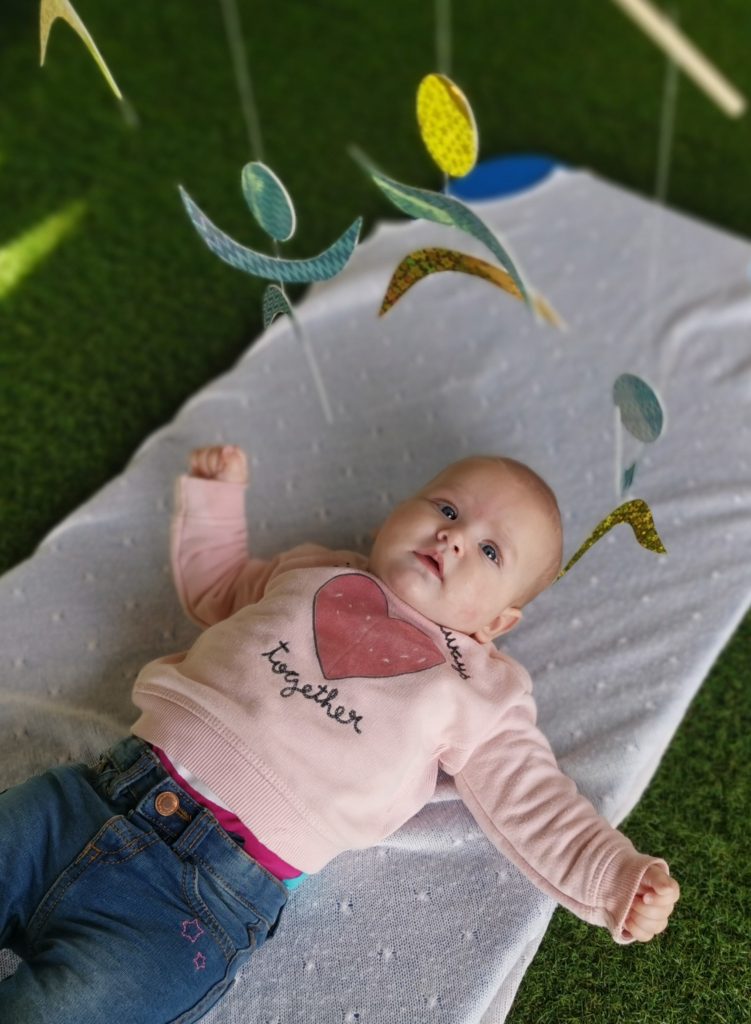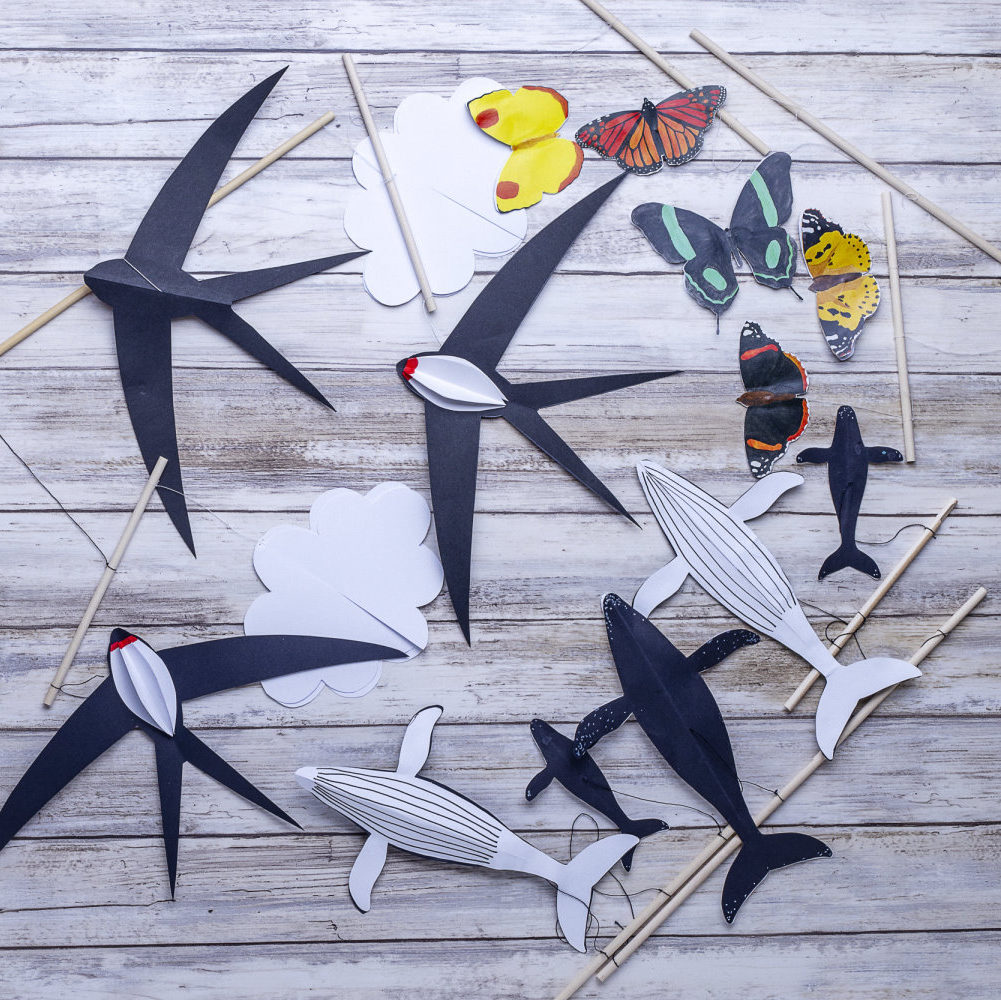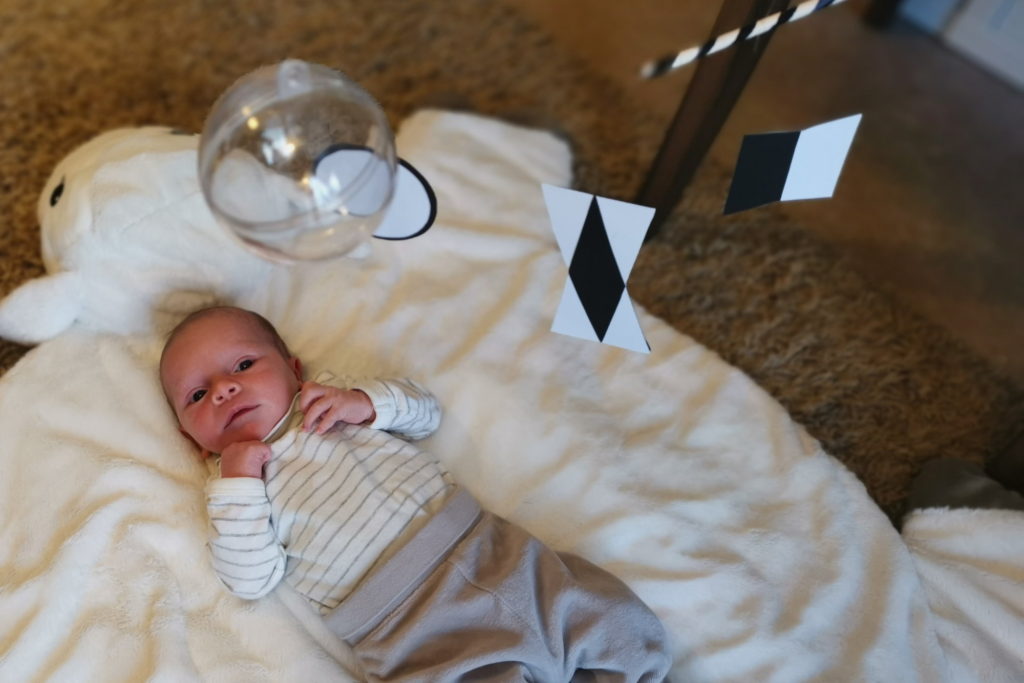Are you expecting? Does it feel like everybody is talking about Montessori visual mobiles around you? I have to say, with good reason, as they have a lot of positive influence on your baby’s (not only visual!) development. They are the bees’ knees! Should you drop everything and quickly go and buy them all right at this second? I invite you to first read about them, then you can make an educated decision based on what you learnt. Here we go!
WHY DO BABIES ‘NEED’ MONTESSORI MOBILES?
Did you know that a newborn’s least developed sense is sight? When they are born, their retina (that controls vision) is blurred because the neurons in their brain are not fully developed. As a result, they can only see black and white colours and shades of grey. Their sight gradually improves in the following 6 months. With the right tools, we can assist them in this process. Read this post to understand what your baby can actually see in what age.
What your baby sees in the first months of their life will have a great impact on their visual skills for a long time. The Montessori visual mobiles are the product of scientific research. They were designed with only one purpose: to aid your little one’s sight development, encompassing the full range of visual skills. Each of them offers just the right amount of stimuli so that the sense of sight is challenged, but not overwhelmed.
WHAT IS THE SEQUENCE OF THE MONTESSORI MOBILES?
The mobiles are part of a determined sequence (read more about the timeline of the Montessori mobiles here). The first one you can present to your baby is the Munari, then the Octahedron, the Gobbi and the Dancers. There is an approximate time frame, so you know when to change from one mobile to another. However, the emphasis here is on ‘approximate’ as every baby has different developmental needs. It is important that you observe your child to know when it’s time to move onto the next one, but as a rule of thumb you would change them every two weeks.
You can use the follow-up Animal Mobiles at the same time, alternating them weekly or as your baby loses interest. Finally, when your baby’s interest shifts from visual to physical, they can use the Montessori Tactile Mobiles.
You can read more about how to make the most of your mobiles in this post.

WHY ARE THEY IMPORTANT?
Babies have to practice coordinating their eyes, how to focus and move them accurately. This is the first step in the long process of understanding the world around them. By learning how to use the visual information that the brain receives, they will prepare the way to use this stimulation to reach and then later to try to grab.
The design of these Montessori visual mobiles specifically aims to guide babies in their visual development. They do this by stimulating dynamic visual tracking (being able to follow a moving object), binocularity (both eyes working together), colour discrimination, size and depth perception and building focus and concentration, just to name the most important ones. Each mobile offers just the right stimulus to the sense of sight for your baby so that s/he is challenged but not overwhelmed. Let’s have a look at some of these in detail.

Visual tracking
One of the main areas of focus of the Montessori mobiles is dynamic visual tracking. This means that the baby’s eyes are able to follow a moving object. This is such an important skill that it can influence a baby for years to come! It is necessary for being able to reach for an object and bat it. To give another example, it will come handy again when your little one starts playing sports or when learning to read. Being able to track the words correctly is one of the foundational skills of reading.
When your child is observing the mobiles, you can clearly see whether they are able to do visual tracking. If you find that they have problems following a moving object with their eyes, please go and see your paediatrician.
https://www.instagram.com/p/CC-q8dmpgZN/
Concentration
Many parents are shocked when they see how transfixed their baby becomes when they see a mobile. Some of them literally stop moving! (Read this post for learning about the reactions babies make when looking at a Montessori mobile). These mobiles focus especially on those visual skills that babies need help with. Babies find them almost irresistible! With capturing their attention, the mobiles encourage observation, which in turn works on building concentration.
Concentration is similar to a muscle. It needs ‘working out’ and a lot of practice. If you nurture it from birth, it will gradually grow longer and longer. Those babies who grow observing Montessori mobiles from birth have a remarkable ability to concentrate. Many babies have the capacity to focus on their mobiles for 20-30 minutes which is a really long time for such a young person! This ability will stay with them and assist them all throughout their education.

WHY ARE MONTESSORI MOBILES SO SPECIAL?
There are a few aspects that we like to apply to all Montessori mobiles. They should look aesthetically pleasing to attract the eye, have simple, graceful lines and a soothing, calming effect. They should not have more than five elements so that the baby’s vision does not get overwhelmed. As with most Montessori materials, mobiles also try to stimulate only one sense, which, in this case, is their sight. Therefore, they should not make any sound.
It is also an important principle that they provide concrete, real-life experiences (as much as possible). That’s why you’ll find that most Montessori and Montessori-inspired mobiles depict geometrical shapes or animals.
The Montessori Animal Mobiles not only offer real images but also emulate the way the animals move. This is the reason why you can only find animals depicted that fly (Butterfly mobile, Swallows mobile, Seagull mobile) or swim (Whale mobile). The lightweight images slowly and gracefully move around so that your baby has opportunities to practice tracking objects, depth perception, and observe differences in colour and size.

HOW TO HANG THE MONTESSORI VISUAL MOBILES?
Here are a few recommendations that you should follow before starting to use a mobile.
- ALWAYS supervise your baby when using a mobile
- Hang it in the baby’s waking space as it is meant to stimulate them instead of relaxing them
- Present it when your baby is fully awake and calm so that they are ready to observe and focus on the mobile
- Position the mobile above the baby’s chest at a height of at least 30cm/12″. This ensures that they can see it but it’s safely out of the baby’s grasp when it moves.
Read more about most common mistakes when hanging a Montessori visual mobile in this post.
HOW TO PLACE A NEWBORN UNDER A MOBILE?
When you are home from the hospital and settled in a bit, after about two weeks you can introduce the Munari mobile. You can leave your baby on a topponcino, which gives a safe and comfortable environment to explore from. If your little one is a bit older, place him/her straight on a movement mat, although I would put a muslin cloth under to avoid accidents. (Read about a Montessori baby’s work space in this post). Make sure that s/he is awake, well-rested and ready to ‘work’.
If you suspect that your baby has reflux, s/he might become fussy while lying flat on the mat. In this case use something to prop your little one up on, for example a soft blanket, a towel or a nursing pillow.

WHAT SHOULD YOU DO?
There are two Montessori principles which apply here called ‘giving time‘ and ‘non-interference‘. They pretty much mean what it says on the tin, asking you to give all the time your baby needs and, if possible, trying not to disrupt this intense observation in any way. Building concentration and learning new visual skills is hard work! What you can do is sit, observe and enjoy watching your little one delight in interacting with the mobiles. Babies are very good at letting us know when they have had enough of this hard work and are ready for a change so follow your child’s cues and act on them!
FINAL THOUGHTS
Do I think that babies need Montessori mobiles to assist in developing their visual skills? Absolutely! Do I think that you can’t do without them? No, you absolutely can! The beauty and the effectiveness of Montessori is not in the expensive materials but in the philosophy, the way we raise our children. I also think that the mobiles should not be the only experiences we offer to our baby. It’s all about what you believe in and what your circumstances allow you to do. I do believe that with a bit of research, you can find many alternative ways to offer similar experiences.
If you’d like to buy the DIY Montessori Mobile set for newborns I made, or any of the above mentioned mobiles individually, please visit my Shop.
Click on the links to read more about how the Montessori Tactile Mobiles or the Sensory Baby Play help your baby’s development.
I would love to see your baby enjoying the mobiles you put together! If you’d like, share your photos on my Instagram site. #montessoriedited, @montessoriedited
